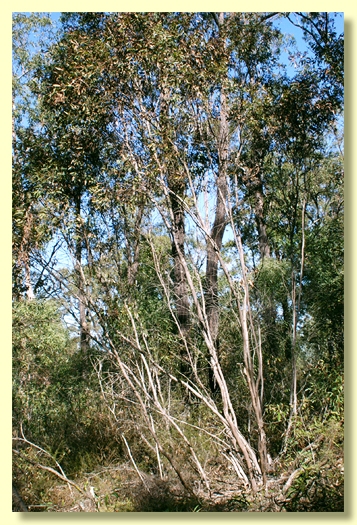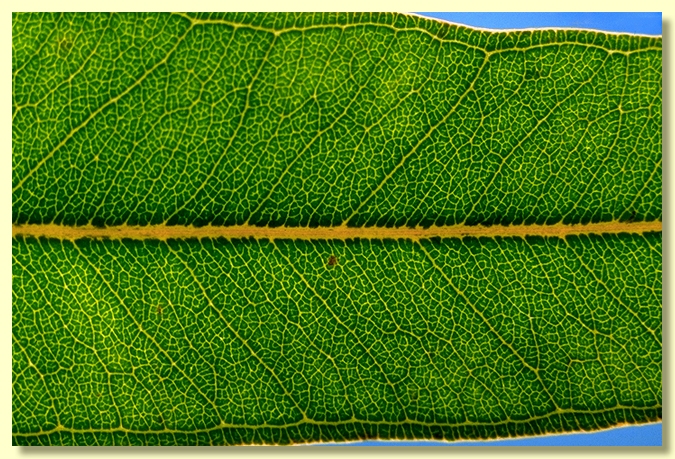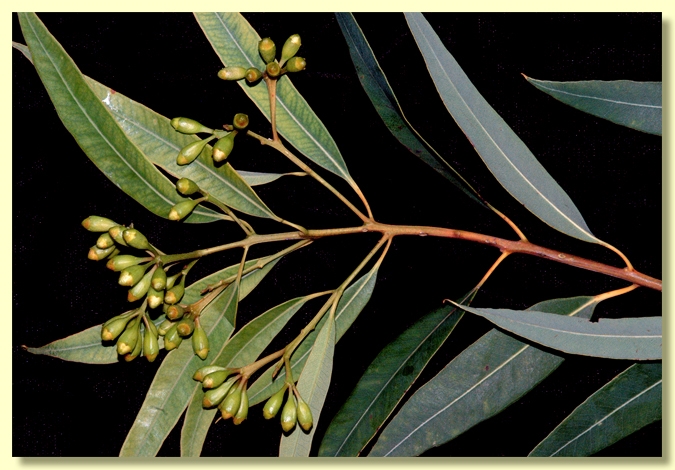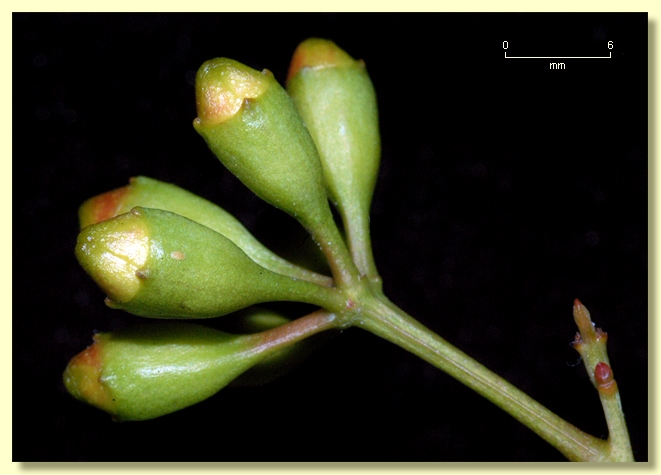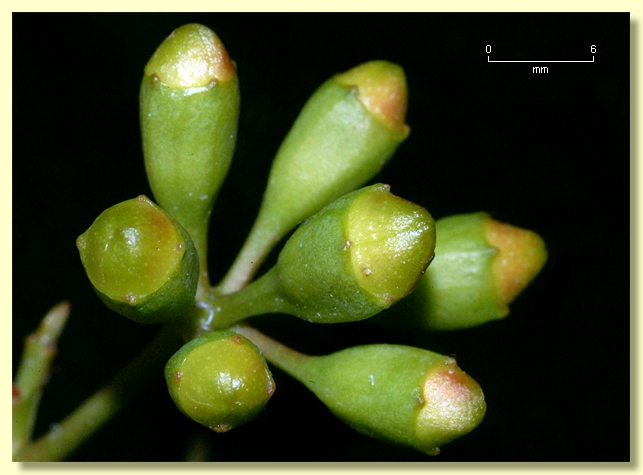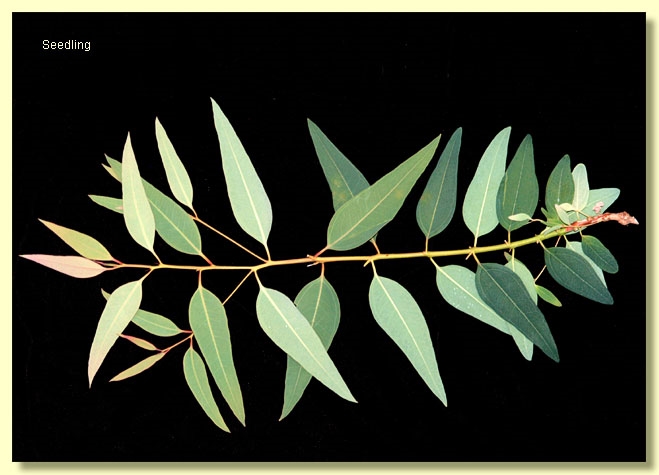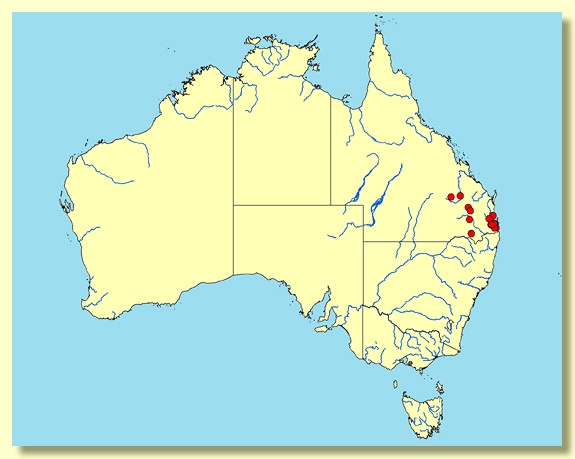Euclid - Online edition
Eucalyptus curtisii
Eucalyptus | Acerosae
Spreading slender-stemmed mallee or small tree to 7 m tall but often much shorter. Forming a lignotuber.
Bark smooth throughout, grey to silvery, shedding in short curly brown flakes.
Branchlets lack oil glands in the pith, non-glaucous.
Juvenile growth (coppice or field seedlings to 50 cm): stem square to rounded in cross-section, glabrous; leaves opposite only at the lowest node then becoming sub-opposite to alternate, petiolate, linear to narrowly lanceolate, 3–6.2 cm long, 0.3–0.6 cm wide, base tapering, apex pointed, discolorous, darker green above.
Adult leaves alternate or sometimes opposite, petiole 0.7–1.8 cm long; blade lanceolate to falcate or sometimes narrowly elliptical, 6.3–14.5 cm long, (0.7)1–3.3 cm wide, flat, base tapering to petiole, strikingly discolorous, glossy, green, side-veins greater than 45° to midrib, densely reticulate, intramarginal vein parallel to and well removed from margin, oil glands obscure or absent.
Inflorescence terminal compound, peduncle slightly angular, 0.7–1.7 cm long, buds 7 per umbel, pedicels 0.2–0.5(0.9). Mature buds pyriform to obovoid or ovoid (0.5–0.8 cm long, 0.4–0.7 cm wide), green basally, paler above, slightly angled longitudinally or scarcely so, with 4 small sepals which persist through to bud maturity or fall early leaving small scars, petals imperfectly united to form a rounded operculum which is shed whole at flowering, stamens regularly inflexed, anthers all fertile, cuboid to oblong, versatile, dorsifixed, dehiscing by longitudinal slits (non-confluent), style long, stigma blunt, locules (4)5 or 6, the placentae each with numerous very elongated ovules terminally attached, not clearly arranged in rows or if vertical rows can be discerned then ca 8–10 rows. Flowers white.
Fruit pedicellate (pedicels 0.1–0.5(0.9) cm long), cupular to ± truncate-globose, 0.5–1.1 cm long, 0.6–1.1 cm wide, sometimes slightly angled but more often just longitudinally wrinkled, disc ± descending, narrow, dehiscence circumcissile by means of a "crown" consisting of a lobed portion of the ovary roof with central style-base lifting from above the (4)5 or 6 locules, and usually with some chaff particles adherent to the underside. (i.e. the "crown" seems to be pushed off the fruit by development of the locule contents.)
Seeds brown, 1–1.8 mm long, < 0.3 mm wide, linear with longitudinal angles and a very small terminal face which is the hilum.
Cultivated seedlings (measured at ca node 10): cotyledons oblong-orbicular; stems square to rounded in cross-section, glabrous; leaves shortly petiolate, opposite for up to 10 nodes, or becoming alternate after ca 4–6 nodes and remaining alternate or reverting to opposite for a few nodes, linear to narrowly oblong, 3.5–8 cm long, 0.5–1.1 cm wide, base tapering, apex pointed, green.
Flowering has been recorded in September, October, November and December.
A shrubby mallee or slender small tree endemic to south-eastern Queensland occurring sporadically from Plunkett south of Beenleigh west to Inglewood, Dalby and Barakula State Forest and extending as far north as the Glasshouse Mountains area, and inland as far as Isla Gorge near Theodore. Eucalyptus curtisii is distinguished from other eucalypts throughout its range by the combination of terminal inflorescences, buds with four small sepals and an inner operculum, fruit dehiscing by a circumcissile cap or "crown" rather than by opening valves, distincty discolorous dull to glossy adult leaves, smooth bark on slender stems and (usually) mallee habit.
In the classification of Brooker (2000) Eucalyptus curtisii occupies a solitary position in Eucalyptus subgenus Acerosae because of the unusual combination of features, viz. terminal inflorescence, free sepals, imperfectly united petals forming an operculum, circumcissile fruit dehiscence, linear seed, discolorous leaves, glabrous juvenile growth and lignotuberous mallee habit.
Eucalyptus curtisii: after Densil Curtis (1892–1973). Densil Curtis was a farmer, naturalist and bushman, from the Beenleigh district of Queensland, the collector of the type specimen.

